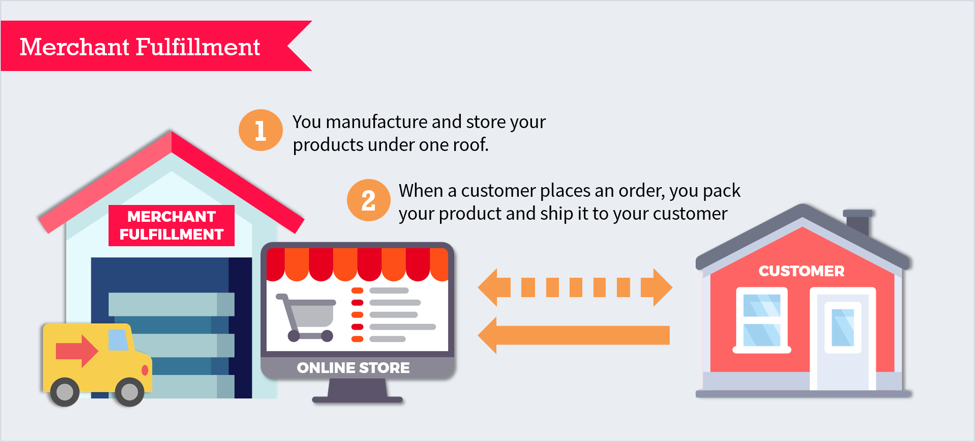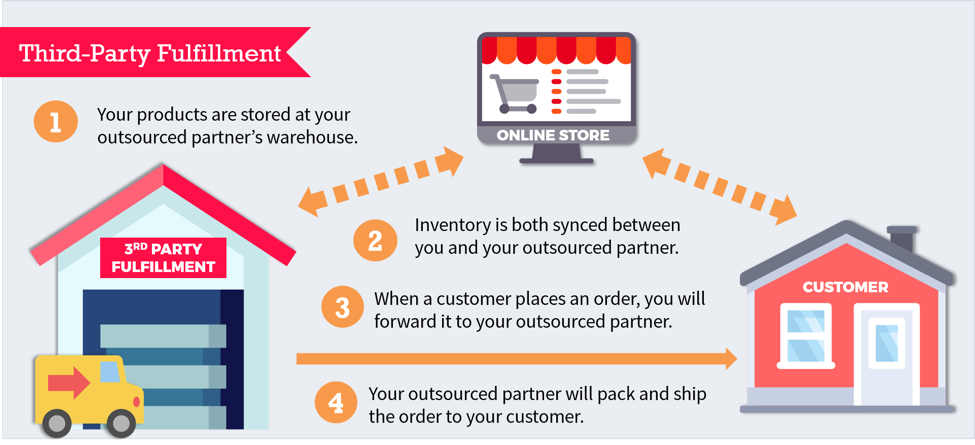An Overview of Order Fulfillment for Your Online Store

It takes a village to make sales on your online storefront.
You’ll need the help of content writers, graphic designers, and marketers to attract people to your store. From there, you’ll need to build a website that’s fast and easy to navigate in order to convert those visitors into customers.
And that’s just the tip of the iceberg. Once a customer places an order, what happens next?
What is Order Fulfillment — And Why is it Important?
Order fulfillment describes everything that happens between the customer from the time their purchase is confirmed to the products arriving at their doorstep. This process includes inventory storage, packaging, and shipping.
And all that aforementioned labor will go to waste if your orders are often lost, delayed, or damaged.
Thirty-eight percent of consumers report that after a negative delivery experience, they would likely never buy from a retailer again. This is what makes order fulfillment so important. One-time purchases aren’t good enough — for your store to survive, you’ll need your customers to keep coming back for more.
In this guide, we’ll review how to properly manage order fulfillment, so you’ll be able to keep your customers happy and maximize your profits.

The 5 Main Steps of Order Fulfillment
To help you better understand order fulfillment, let’s review each of the steps that are involved in this process in more detail:
- Receiving: Incoming inventory arrives and is accepted at the warehouse. It must be inspected for damage and, if necessary, labeled for storage.
- Storage: Inventory is organized into dedicated storage locations (shelves, bins, pallets, etc.) so that it can be quickly retrieved when needed. The warehouse will need to constantly monitor which items are being added and removed from storage to ensure inventory levels are kept accurate.
- Picking: When an order is placed, a warehouse worker will receive a slip that tells them the quantities and locations of the items that are to be “picked” from storage and taken to a packing station.
- Packing: Picked items are once again inspected for damage, and then they are packaged and labeled for shipping. Sometimes only boxes and tape are necessary for packing, but delicate items may also require bubble wrap or air pillows. Branded packaging material, promotional inserts, and other customized elements are also options at this stage.
- Shipping: The size, weight, and other details of the order are all considered to determine the best shipping method. A notification should be sent to the customer at this point so they’ll know to expect the arrival of their order soon.
In addition to these steps, there’s also a sort of unspoken agreement between ecommerce buyers and sellers — in exchange for not being able to see or feel an item in person before they purchase it, buyers will expect your returns process to be fast and easy. If they have trouble getting a refund, that experience very well might lead them to never buy from your store again.
So, returns are the true last stage of the order fulfillment process. You must have a clear return policy for customers to reference, and you’ll need to process the refunds for approved returns as quickly as possible. This also feeds back into the storage step, as items that are returned but undamaged can be saved and then sold to another customer later.
In-House (or Merchant) Order Fulfillment
When your store is just starting out, it will likely make more sense to handle order fulfillment yourself instead of using a third-party order fulfillment company.
Order fulfillment companies will charge you for their services, of course, and at first, you’ll have more time available than money. Also, many order fulfillment companies have volume minimums that must be met to use their services, so this might not even be an option for you initially.
Instead of paying to use an order fulfillment company’s warehouse workers and facilities, you can use your own labor for packaging and shipping and a spare room or garage for storage. This is known as in-house or merchant order fulfillment.

Even stores that are well-established and ship out a high volume of orders may get the most benefit from in-house fulfillment if they regularly deal with orders that require special packaging.
While there are many order fulfillment companies that offer a high degree of customization, such as “kitting” different items together into one SKU or even assembling items on the spot, it might be easier to just handle this yourself if you need specialized equipment or your order fulfillment process is atypical in some other way.
Outsourcing (or Third-Party) Order Fulfillment
Once your orders per day reach double-digits, you’re probably going to find that fulfillment takes too much time to do yourself. To run your business, you need to deal with sales, marketing, developing your product line, and many other tasks — you can’t afford to spend entire afternoons just packing boxes.
At this point, you could hire some employees to help. Of course, you’ll eventually run out of room in your house as well, so you’ll also need to invest in warehouse space and equipment. This all adds up to a huge total that even medium-sized stores might not be able to afford.
Another issue is that investing in your own warehouses is inflexible. Maybe you can afford these expenses now, but what if your orders and revenue drop suddenly? Breaking the lease for your warehouse and shedding all the other infrastructure you’ve built up would be a time-consuming and expensive process.
Conversely, if your orders skyrocket out of nowhere, you might not have enough infrastructure to satisfy all the new demand. This could result in delayed/canceled orders, frustrated customers, and a damaged reputation.

In these scenarios, third-party fulfillment is the way to go.
Order fulfillment companies offer a solution that’s much more affordable and scalable. These services have the capacity to handle anything you throw at them, and they allow you to scale up and down with ease.
How to Select an Order Fulfillment Company
Once you’ve made the decision to use an order fulfillment company, you’ll then need to decide which one makes the most sense for your store.
There are certainly plenty of options to choose from — to make the best decision, consider the following factors before you make a commitment:
- Warehouse Location: Thanks to Amazon, two-day shipping has become the standard in ecommerce (a 2019 National Retail Federation survey found that 39% of online shoppers expect free two-day shipping to be an option at checkout). To make this service available, your warehouse will need to be relatively close to where your customers are located.
- Warehouse Quantity: If your customers are widely dispersed, then you’re going to need more than one warehouse in order to offer fast shipping to everyone (this is especially important if you have international customers).
- Security: Many order fulfillment companies have “breakage” or “shrinkage” built into their contracts, which means that you’re responsible for the cost of lost or damaged items up to a certain point. Can you trust them to protect your products from being stolen? Look for companies that include features such as video monitoring, access control measures (keycards, biometric scanning, etc.), and background checks on warehouse workers.
- Integration: If the order fulfillment company’s software integrates with the ecommerce platform you use, that will make it much easier for you to keep track of your inventory and everything else that’s involved with the order fulfillment process.
- Customer Support: When you only have two days to get products to the customer, any issues that pop up must be dealt with right away. Ideally, your order fulfillment company will offer 24/7 support instead of requiring you to leave a message and wait for them to get back to you.
- Cost: Of course, it all comes down to the bottom line. If you have a big enough budget, you may be able to afford a service that excels in all of the metrics listed above. Otherwise, you’ll need to prioritize which features are most important to you.
The Top 5 Order Fulfillment Companies
While it’s true that each order fulfillment company has its own set of pros and cons, and what works well for one store might not work well for another, some order fulfillment companies still stand out above the rest.
For the majority of online stores, one of the following five options would be an excellent fit:
1. Fulfillify
This is an excellent option for smaller stores. With rates starting at $1.99 per order (with an additional charge of 50 cents for every item after the first item), pick-and-pack services don’t get much more affordable than this. The company also charges a monthly fee of $12 per pallet for receiving products and a monthly fee of $12.50 per pallet for product storage.
Fulfillify has four warehouses in the United States, allowing the company to provide two-day shipping to over 98% of the country’s population.
2. ShipMonk
ShipMonk is slightly more expensive than Fulfillify for smaller stores, with rates starting at $2.50 per order and 50 cents for every item after the first item (though the company does offer a bulk discount that goes all the way down to $1.50 per order and 30 cents for each additional item for stores that ship 5,000+ orders per month). This option features three warehouses in the U.S., and ShipMonk’s warehouse automation technology allows the company to guarantee 99.9% picking accuracy.
3. eFulfillmentService
This is another strong option for small/low-volume stores, as eFulfillmentService has no order minimums or long-term contracts, and its prices are low as well.
Another advantage to eFulfillmentService is that the company offers a cross-docking service, which involves orders being received at the warehouse and then immediately shipped out without being stored. This is especially helpful for crowdfunded projects that are under pressure to send new products to their financial backers as soon as they’re complete.
4. Rakuten Super Logistics
Unlike the first three services here, Rakuten Super Logistics is more of a premium than a budget option. For one thing, you’ll need to move at least 250 orders per month to use this service.
If Rakuten sounds familiar, that may be because it’s the biggest ecommerce company in Japan. With its Super Logistics spin-off service, Rakuten allows other stores to piggyback off its infrastructure (15 fulfillment centers in the U.S.) in exchange for a fee.
In addition to the high number of warehouses, Rakuten Super Logistics also guarantees a high quality of service — the company promises 100% order accuracy and 100% order turnaround by the next business day.
5. Fulfillment by Amazon
Finally, this guide wouldn’t be complete without touching on the fulfillment service offered by the biggest ecommerce company in the U.S., Amazon.
Fulfillment by Amazon (FBA) is similar to Rakuten Super Logistics in that it allows you to take advantage of an ecommerce enterprise’s existing infrastructure. And in this case, the infrastructure is downright massive: Amazon maintains 170 fulfillment centers, which add up to 150 million square feet of warehouse space, and a workforce of 250,000 full-time employees. With these resources, there’s no more efficient way to get products from Point A to Point B.
As far as costs go, FBA has the following policy for what it defines as small-sized standard packages:
- Longest side: 15 inches or less
- Shortest side: 0.75 inches or less
- Median side: 12 inches or less
- Cost: $2.41 for 10 ounces or less, $2.48 for 10 to 16 ounces
For large-sized standard packages:
- Longest side: 18 inches or less
- Shortest side: 8 inches or less
- Median side: 14 inches or less
- Cost: $3.19 for 10 ounces or less, $3.28 for 10 to 16 ounces, $4.76 for 1 to 2 pounds, $5.26 for over 2 pounds (there’s an additional charge of 38 cents per pound after the first 3 pounds)
And for standard package storage, Amazon charges 69 cents per cubic foot for standard-sized packages in January to September and $2.40 per cubic foot in October to December (this price difference is due to the surge in demand during the holiday season).
The biggest benefit of FBA is that it makes your products Prime-eligible, which means Amazon Prime subscribers (which describes 82% of U.S. households) can order them with free two-day shipping. As you already know, online shoppers love free two-day shipping. The potential for massive sales growth that’s provided here simply can’t be ignored.

Choosing the Right Setup for Your Online Store
Depending on the size of your business and financials, one order fulfillment setup may make sense now and then change down the line. It’s essential to keep good order records so that you can pivot when the time is right — without sacrificing the integrity of your online store or alienating your customers.

Adam Ritchie
Adam Ritchie is a writer based in Silver Spring, Maryland. He writes about ecommerce trends and best practices for Shogun. His previous clients include Groupon, Clutch and New Theory.



